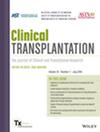Hepatitis B Vaccine Compliance, Serologic Response, and Durability in Adult Thoracic Organ Transplant Recipients
Abstract
Introduction
Hepatitis B virus (HBV) vaccination is recommended for solid organ transplant (SOT) candidates. However, there is a lack of data on the HBV vaccine compliance, serologic response, and durability of HBV seroprotection in thoracic organ transplantation recipients.
Methods
We conducted a retrospective study of adult thoracic organ (heart and lung) transplant candidates who received HBV vaccination at Mayo Clinic sites in Minnesota, Arizona, and Florida between January 2018 and August 2023. Conventional recombinant hepatitis B vaccine (Recombivax HB) was used before 2020, and Heplisav-B was preferred after 2020. HBV seroprotection was defined as hepatitis B surface antibody (HBsAb) ≥ 10 IU/L. Furthermore, we compared characteristics between recipients who maintained HBV seroprotection and those who lost HBV seroprotection (HBsAb < 10 IU/L) at 30 days posttransplantation (D30).
Results
Among 922 candidates who were eligible for HBV vaccination, 430 (47%) completed the HBV vaccine series. Patients receiving Heplisav-B were more likely to complete the series than Recombivax HB (81% vs. 60%, p < 0.001) and Heplisav-B had a higher seroprotection rate than Recombivax HB (75% vs. 64%, p = 0.023). Multivariate logistic regression analysis identified receiving Heplisav-B as an independent predictor for HBV seroprotection (adjusted odds ratio [aOR] 1.723; 95% confidence interval [CI] 1.056–2.810; p = 0.029). A total of 145 thoracic organ transplant recipients achieved HBV seroprotection at the date of transplantation. Loss of HBV seroprotection occurred in 38 (26%) patients at D30. Multivariate logistic regression analysis identified two predictors for HBV seroprotection loss at D30: age ≥ 60 years (aOR, 2.503; 95% CI 1.026–6.107; p = 0.044), and pretransplant HBsAb level between 10 and 100 IU/L (aOR, 18.575; 95% CI 5.211–66.209; p < 0.001).
Conclusions
Although less than half of thoracic organ transplant candidates completed HBV vaccine series pretransplant, Heplisav-B provided a higher vaccine completion rate and seroprotection than the 3-dose Recombivax HB. Clinicians should also be aware of the increased loss of HBV seroprotection in thoracic organ transplant recipients with age ≥ 60 years and pretransplant HBsAb between 10 and 100 IU/L. Assessment of seroprotection after HBV vaccination should be prioritized during the pretransplant period.

 求助内容:
求助内容: 应助结果提醒方式:
应助结果提醒方式:


